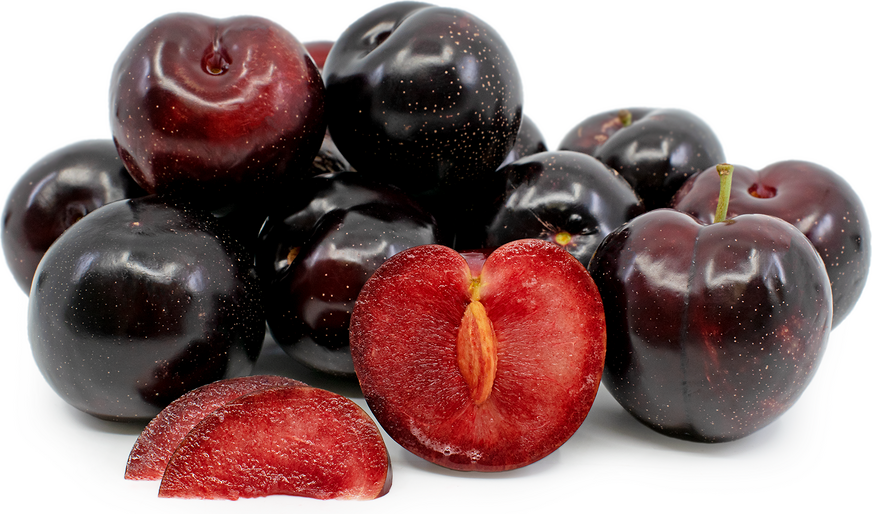


Burgundy Plums
Estimated Inventory, cs : 0
Description/Taste
Burgundy plums are a small to medium-sized varietal averaging 4 to 5 centimeters in diameter and have a round, oval, to cordate shape with a main suture line extending the length of the fruit. The plum's skin is smooth, taut, and glossy, showcasing pigmented hues of dark purple and red, sometimes appearing almost black. The skin is also covered in tiny pale-yellow dots, giving the surface a speckled appearance, and a bloom occasionally covers the skin, creating a powdery texture that can be easily wiped away. Underneath the surface, the bright red to crimson flesh is firm, aqueous, and crisp with a snap-like, crunchy consistency. A small pit is also found in the center of the flesh, and this variety is a semi-freestone type, meaning the flesh only clings slightly to the pit, sometimes known as a stone. Burgundy plums have a mild, sweet flavor with little to no acidity, followed by subtle wine-like nuances in the fruit's lingering aftertaste.
Seasons/Availability
Burgundy plums are available in the summer.
Current Facts
Burgundy plums, botanically classified as Prunus salicina, are a specialty variety belonging to the Rosaceae family. The early to mid-season plums are a type of Japanese plum that grows on a tree reaching 3 to 4 meters in height. Burgundy plums are named for their dark skin coloring and saturated, pigmented flesh. They are a self-fertile variety, meaning they do not require additional trees to be planted nearby for pollination. The plums are also valued for their productive nature, producing large fruit crops with disease resistance, hardiness, and sweet flavors. Despite its favorable growth characteristics, Burgundy plums are not commercially cultivated and are primarily a home garden or boutique plum grown by select farms. Burgundy plums are one of the largest crop-producing plum varieties and can remain on the tree for extended periods without spoiling, allowing growers to harvest the fruits as needed. The plum trees are also typically planted near other stone fruits, such as pluots, to act as a pollinator for those varieties. Burgundy plums are a versatile, all-purpose variety suitable for a wide array of fresh and cooked preparations.
Nutritional Value
Burgundy plums are a source of vitamin C to strengthen the immune system, vitamin A to maintain healthy organ functioning, and vitamin K to assist in faster wound healing. The plums also provide fiber to regulate the digestive tract, potassium to balance fluid levels within the body, iron to develop the protein hemoglobin for oxygen transport through the bloodstream, and other nutrients, including manganese, folate, phosphorus, and magnesium. The fruit's pigmented skin and flesh contain phytonutrients and polyphenols that offer high levels of antioxidants to reduce inflammation and protect the cells against external damage caused by free radicals.
Applications
Burgundy plums have a mild, sweet flavor suited for fresh and cooked preparations. The plums should be washed and dried before consumption and it is important to note that the juice may stain fabric and clothing. Burgundy plums are traditionally consumed straight out of hand, or the plums can be sliced and layered into parfaits, mixed into fruit medleys, chopped into salads, or served with fresh cheeses as an appetizer. The plums can also be pressed into juice and combined into cocktails, smoothies, salad dressings, and sauces. Beyond fresh preparations, Burgundy plums can be made into chutney, cooked into sauces for savory meats, or simmered into jellies, jams, and preserves. The fruits can also be baked into crisps, scones, pies, cakes, tarts, and muffins, or cooked into a syrup and drizzled over ice cream and other desserts. Try incorporating Burgundy plums into savory dishes such as meat mains or grilling for an enhanced, smoky-sweet flavor. The plums can also be canned or dried for extended use. Burgundy plums pair well with spices such as cinnamon, ginger, and nutmeg, fruits including nectarines, cherries, raspberries, bananas, and apricots, vanilla, caramel, sesame, and cheeses such as gruyere, blue cheese, fontina, and taleggio. Whole, unwashed Burgundy plums will generally keep for 2 to 3 days at room temperature, sometimes longer depending on the need for ripening. Once ripe, it is recommended to store the fruits in the refrigerator, where they will last for 3 to 5 days.
Ethnic/Cultural Info
Burgundy plums are a type of blood plum, a general descriptor used for varieties that showcase dark red-purple, speckled skin, and maroon flesh. The colored pigments are a natural mutation created over time in plum varieties and this coloring also indicates a higher antioxidant content. Burgundy plums are also a Japanese plum cultivar, the most popular category of plums grown in California. Japanese and European plums are the two types of plums commercially produced in California for fresh market consumption. The state grows approximately 70% to 90% of the plums sold in the United States, depending on the year. Japanese plums were introduced in California in the late 19th century and are mainly planted in the San Joaquin and Santa Clara Valleys.
Geography/History
Burgundy plums are native to California and were believed by experts to have been developed sometime in the late 20th century. The history and parentage of the variety are unknown, but some experts speculate that the plums are descendants of the red-fleshed Mariposa plum and the El Dorado plum. After its discovery, Burgundy plums were deemed too small for commercial production, but they became a favored variety for specialty growers and home gardeners, cultivated for the fruit's sweet flavor and crisp, pigmented flesh. Burgundy plums thrive in regions with dry, mild winters and are primarily offered through nurseries and online retailers for home garden use. The plums can also be found fresh through farmers markets, direct from the grower, or through distributors in the United States.
Recipe Ideas
Recipes that include Burgundy Plums. One
| The Castaway Kitchen |
|
Plum & Prosciutto Chicken |
| Cuesa- Cultivating a Healty Food System |
|
Burgundy Plum and Ginger Jam |
Podcasts

















